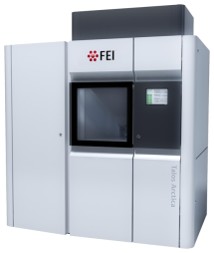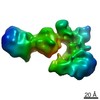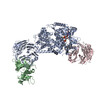[English] 日本語
 Yorodumi
Yorodumi- EMDB-21311: Cryo-EM map of C-terminal half of Leucine Rich Repeat Kinase 2 as... -
+ Open data
Open data
- Basic information
Basic information
| Entry | Database: EMDB / ID: EMD-21311 | ||||||||||||
|---|---|---|---|---|---|---|---|---|---|---|---|---|---|
| Title | Cryo-EM map of C-terminal half of Leucine Rich Repeat Kinase 2 as a COR-COR domain dimer in the presence of the MLi-2 kinase inhibitor at 9.0 angstroms | ||||||||||||
 Map data Map data | 9.04A map of a Leucine Rich Repeat Kinase 2 truncate as a COR mediated dimer | ||||||||||||
 Sample Sample |
| ||||||||||||
| Biological species |   Homo sapiens (human) Homo sapiens (human) | ||||||||||||
| Method |  single particle reconstruction / single particle reconstruction /  cryo EM / Resolution: 9.0 Å cryo EM / Resolution: 9.0 Å | ||||||||||||
 Authors Authors | Leschziner A / Deniston C / Lahiri I | ||||||||||||
| Funding support |  United States, 3 items United States, 3 items
| ||||||||||||
 Citation Citation |  Journal: Nature / Year: 2020 Journal: Nature / Year: 2020Title: Structure of LRRK2 in Parkinson's disease and model for microtubule interaction. Authors: C K Deniston / J Salogiannis / S Mathea / D M Snead / I Lahiri / M Matyszewski / O Donosa / R Watanabe / J Böhning / A K Shiau / S Knapp / E Villa / S L Reck-Peterson / A E Leschziner /     Abstract: Leucine-rich repeat kinase 2 (LRRK2) is the most commonly mutated gene in familial Parkinson's disease and is also linked to its idiopathic form. LRRK2 has been proposed to function in membrane ...Leucine-rich repeat kinase 2 (LRRK2) is the most commonly mutated gene in familial Parkinson's disease and is also linked to its idiopathic form. LRRK2 has been proposed to function in membrane trafficking and colocalizes with microtubules. Despite the fundamental importance of LRRK2 for understanding and treating Parkinson's disease, structural information on the enzyme is limited. Here we report the structure of the catalytic half of LRRK2, and an atomic model of microtubule-associated LRRK2 built using a reported cryo-electron tomography in situ structure. We propose that the conformation of the LRRK2 kinase domain regulates its interactions with microtubules, with a closed conformation favouring oligomerization on microtubules. We show that the catalytic half of LRRK2 is sufficient for filament formation and blocks the motility of the microtubule-based motors kinesin 1 and cytoplasmic dynein 1 in vitro. Kinase inhibitors that stabilize an open conformation relieve this interference and reduce the formation of LRRK2 filaments in cells, whereas inhibitors that stabilize a closed conformation do not. Our findings suggest that LRRK2 can act as a roadblock for microtubule-based motors and have implications for the design of therapeutic LRRK2 kinase inhibitors. | ||||||||||||
| History |
|
- Structure visualization
Structure visualization
| Movie |
 Movie viewer Movie viewer |
|---|---|
| Structure viewer | EM map:  SurfView SurfView Molmil Molmil Jmol/JSmol Jmol/JSmol |
| Supplemental images |
- Downloads & links
Downloads & links
-EMDB archive
| Map data |  emd_21311.map.gz emd_21311.map.gz | 9.7 MB |  EMDB map data format EMDB map data format | |
|---|---|---|---|---|
| Header (meta data) |  emd-21311-v30.xml emd-21311-v30.xml emd-21311.xml emd-21311.xml | 20.2 KB 20.2 KB | Display Display |  EMDB header EMDB header |
| FSC (resolution estimation) |  emd_21311_fsc.xml emd_21311_fsc.xml | 6.8 KB | Display |  FSC data file FSC data file |
| Images |  emd_21311.png emd_21311.png | 61.7 KB | ||
| Others |  emd_21311_half_map_1.map.gz emd_21311_half_map_1.map.gz emd_21311_half_map_2.map.gz emd_21311_half_map_2.map.gz | 18 MB 18 MB | ||
| Archive directory |  http://ftp.pdbj.org/pub/emdb/structures/EMD-21311 http://ftp.pdbj.org/pub/emdb/structures/EMD-21311 ftp://ftp.pdbj.org/pub/emdb/structures/EMD-21311 ftp://ftp.pdbj.org/pub/emdb/structures/EMD-21311 | HTTPS FTP |
-Related structure data
- Links
Links
| EMDB pages |  EMDB (EBI/PDBe) / EMDB (EBI/PDBe) /  EMDataResource EMDataResource |
|---|
- Map
Map
| File |  Download / File: emd_21311.map.gz / Format: CCP4 / Size: 19.4 MB / Type: IMAGE STORED AS FLOATING POINT NUMBER (4 BYTES) Download / File: emd_21311.map.gz / Format: CCP4 / Size: 19.4 MB / Type: IMAGE STORED AS FLOATING POINT NUMBER (4 BYTES) | ||||||||||||||||||||||||||||||||||||||||||||||||||||||||||||
|---|---|---|---|---|---|---|---|---|---|---|---|---|---|---|---|---|---|---|---|---|---|---|---|---|---|---|---|---|---|---|---|---|---|---|---|---|---|---|---|---|---|---|---|---|---|---|---|---|---|---|---|---|---|---|---|---|---|---|---|---|---|
| Annotation | 9.04A map of a Leucine Rich Repeat Kinase 2 truncate as a COR mediated dimer | ||||||||||||||||||||||||||||||||||||||||||||||||||||||||||||
| Voxel size | X=Y=Z: 2.32 Å | ||||||||||||||||||||||||||||||||||||||||||||||||||||||||||||
| Density |
| ||||||||||||||||||||||||||||||||||||||||||||||||||||||||||||
| Symmetry | Space group: 1 | ||||||||||||||||||||||||||||||||||||||||||||||||||||||||||||
| Details | EMDB XML:
CCP4 map header:
| ||||||||||||||||||||||||||||||||||||||||||||||||||||||||||||
-Supplemental data
-Half map: Half map 1 of COR mediated dimer map
| File | emd_21311_half_map_1.map | ||||||||||||
|---|---|---|---|---|---|---|---|---|---|---|---|---|---|
| Annotation | Half map 1 of COR mediated dimer map | ||||||||||||
| Projections & Slices |
| ||||||||||||
| Density Histograms |
-Half map: Half map 2 of COR mediated dimer map
| File | emd_21311_half_map_2.map | ||||||||||||
|---|---|---|---|---|---|---|---|---|---|---|---|---|---|
| Annotation | Half map 2 of COR mediated dimer map | ||||||||||||
| Projections & Slices |
| ||||||||||||
| Density Histograms |
- Sample components
Sample components
-Entire : Truncated Leucine Rich Repeat Kinase 2 as a COR-COR domain mediat...
| Entire | Name: Truncated Leucine Rich Repeat Kinase 2 as a COR-COR domain mediated dimer in the presence of the MLi-2 kinase inhibitor. |
|---|---|
| Components |
|
-Supramolecule #1: Truncated Leucine Rich Repeat Kinase 2 as a COR-COR domain mediat...
| Supramolecule | Name: Truncated Leucine Rich Repeat Kinase 2 as a COR-COR domain mediated dimer in the presence of the MLi-2 kinase inhibitor. type: organelle_or_cellular_component / ID: 1 / Parent: 0 / Macromolecule list: all Details: A COR-COR (9.0A) mediated dimer of truncated Leucine Rich Repeat Kinase 2 starting at residue 1327 all the way to the C-terminal in the presence of the MLi-2 kinase inhibitor at 5uM. |
|---|---|
| Source (natural) | Organism:   Homo sapiens (human) Homo sapiens (human) |
| Molecular weight | Theoretical: 274 KDa |
| Recombinant expression | Organism:   Spodoptera frugiperda (fall armyworm) Spodoptera frugiperda (fall armyworm) |
-Macromolecule #1: Leucine Rich Repeat Kinase 2
| Macromolecule | Name: Leucine Rich Repeat Kinase 2 / type: protein_or_peptide / ID: 1 / Enantiomer: LEVO / EC number:  non-specific serine/threonine protein kinase non-specific serine/threonine protein kinase |
|---|---|
| Source (natural) | Organism:   Homo sapiens (human) Homo sapiens (human) |
| Recombinant expression | Organism:   Spodoptera frugiperda (fall armyworm) Spodoptera frugiperda (fall armyworm) |
| Sequence | String: KKAVPYNRMK LMIVGNTGSG KTTLLQQLMK TKKSDLGMQS ATVGIDVKDW PIQIRDKRKR DLVLNVWDFA GREE FYSTH PHFMTQRALY LAVYDLSKGQ AEVDAMKPWL FNIKARASSS PVILVGTHLD VSDEKQRKAC MSKIT KELL NKRGFPAIRD YHFVNATEES ...String: KKAVPYNRMK LMIVGNTGSG KTTLLQQLMK TKKSDLGMQS ATVGIDVKDW PIQIRDKRKR DLVLNVWDFA GREE FYSTH PHFMTQRALY LAVYDLSKGQ AEVDAMKPWL FNIKARASSS PVILVGTHLD VSDEKQRKAC MSKIT KELL NKRGFPAIRD YHFVNATEES DALAKLRKTI INESLNFKIR DQLVVGQLIP DCYVELEKII LSERKN VPI EFPVIDRKRL LQLVRENQLQ LDENELPHAV HFLNESGVLL HFQDPALQLS DLYFVEPKWL CKIMAQI LT VKVEGCPKHP KGIISRRDVE KFLSKKRKFP KNYMSQYFKL LEKFQIALPI GEEYLLVPSS LSDHRPVI E LPHCENSEII IRLYEMPYFP MGFWSRLINR LLEISPYMLS GRERALRPNR MYWRQGIYLN WSPEAYCLV GSEVLDNHPE SFLKITVPSC RKGCILLGQV VDHIDSLMEE WFPGLLEIDI CGEGETLLKK WALYSFNDGE EHQKILLDD LMKKAEEGDL LVNPDQPRLT IPISQIAPDL ILADLPRNIM LNNDELEFEQ APEFLLGDGS F GSVYRAAY EGEEVAVKIF NKHTSLRLLR QELVVLCHLH HPSLISLLAA GIRPRMLVME LASKGSLDRL LQ QDKASLT RTLQHRIALH VADGLRYLHS AMIIYRDLKP HNVLLFTLYP NAAIIAKIAD YGIAQYCCRM GIK TSEGTP GFRAPEVARG NVIYNQQADV YSFGLLLYDI LTTGGRIVEG LKFPNEFDEL EIQGKLPDPV KEYG CAPWP MVEKLIKQCL KENPQERPTS AQVFDILNSA ELVCLTRRIL LPKNVIVECM VATHHNSRNA SIWLG CGHT DRGQLSFLDL NTEGYTSEEV ADSRILCLAL VHLPVEKESW IVSGTQSGTL LVINTEDGKK RHTLEK MTD SVTCLYCNSF SKQSKQKNFL LVGTADGKLA IFEDKTVKLK GAAPLKILNI GNVSTPLMCL SESTNST ER NVMWGGCGTK IFSFSNDFTI QKLIETRTSQ LFSYAAFSDS NIITVVVDTA LYIAKQNSPV VEVWDKKT E KLCGLIDCVH FLREVMVKEN KESKHKMSYS GRVKTLCLQK NTALWIGTGG GHILLLDLST RRLIRVIYN FCNSVRVMMT AQLGSLKNVM LVLGYNRKNT EGTQKQKEIQ SCLTVWDINL PHEVQNLEKH IEVRKELAEK MRRTSVE |
-Experimental details
-Structure determination
| Method |  cryo EM cryo EM |
|---|---|
 Processing Processing |  single particle reconstruction single particle reconstruction |
| Aggregation state | particle |
- Sample preparation
Sample preparation
| Concentration | 0.5 mg/mL | ||||||||||||||||||||||||
|---|---|---|---|---|---|---|---|---|---|---|---|---|---|---|---|---|---|---|---|---|---|---|---|---|---|
| Buffer | pH: 7.4 Component:
| ||||||||||||||||||||||||
| Grid | Model: Quantifoil, UltrAuFoil, R1.2/1.3 / Material: GOLD / Pretreatment - Type: GLOW DISCHARGE | ||||||||||||||||||||||||
| Vitrification | Cryogen name: ETHANE / Chamber humidity: 100 % / Chamber temperature: 277.15 K / Instrument: FEI VITROBOT MARK II | ||||||||||||||||||||||||
| Details | This sample was imaged over a number of datasets. Specimen concentrations ranged from 0.375(3uM)-0.5(4uM) mg/mL, however the average was 0.5 and thus was entered as the reported specimen concentration. |
- Electron microscopy
Electron microscopy
| Microscope | FEI TALOS ARCTICA |
|---|---|
| Electron beam | Acceleration voltage: 200 kV / Electron source:  FIELD EMISSION GUN FIELD EMISSION GUN |
| Electron optics | Illumination mode: FLOOD BEAM / Imaging mode: BRIGHT FIELD Bright-field microscopy / Cs: 2.7 mm / Nominal defocus max: 2.0 µm / Nominal defocus min: 1.0 µm / Nominal magnification: 36000 Bright-field microscopy / Cs: 2.7 mm / Nominal defocus max: 2.0 µm / Nominal defocus min: 1.0 µm / Nominal magnification: 36000 |
| Sample stage | Specimen holder model: FEI TITAN KRIOS AUTOGRID HOLDER / Cooling holder cryogen: NITROGEN |
| Image recording | Film or detector model: GATAN K2 SUMMIT (4k x 4k) / Detector mode: COUNTING / Number real images: 4030 / Average exposure time: 9.5 sec. / Average electron dose: 5.5 e/Å2 Details: Image lengths of either 9 seconds or 10 seconds were collected. |
| Experimental equipment |  Model: Talos Arctica / Image courtesy: FEI Company |
 Movie
Movie Controller
Controller


















 Z
Z Y
Y X
X


















